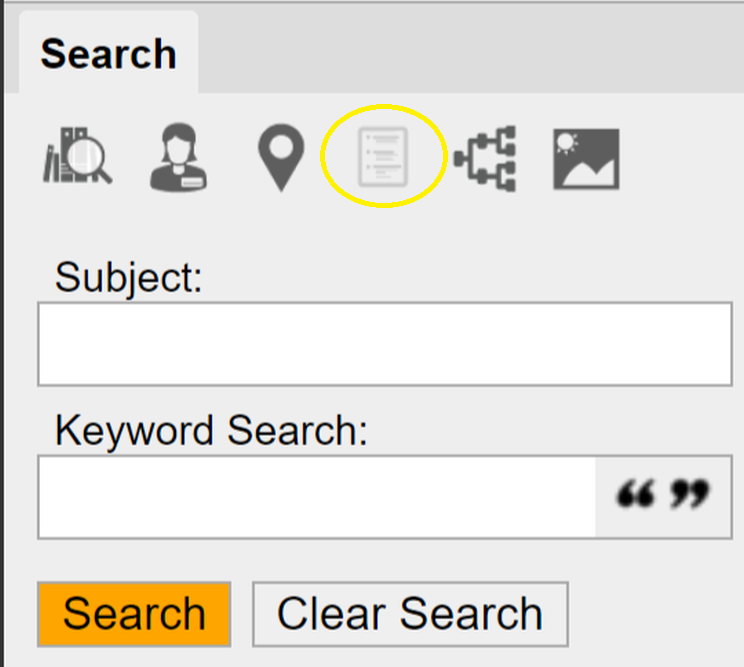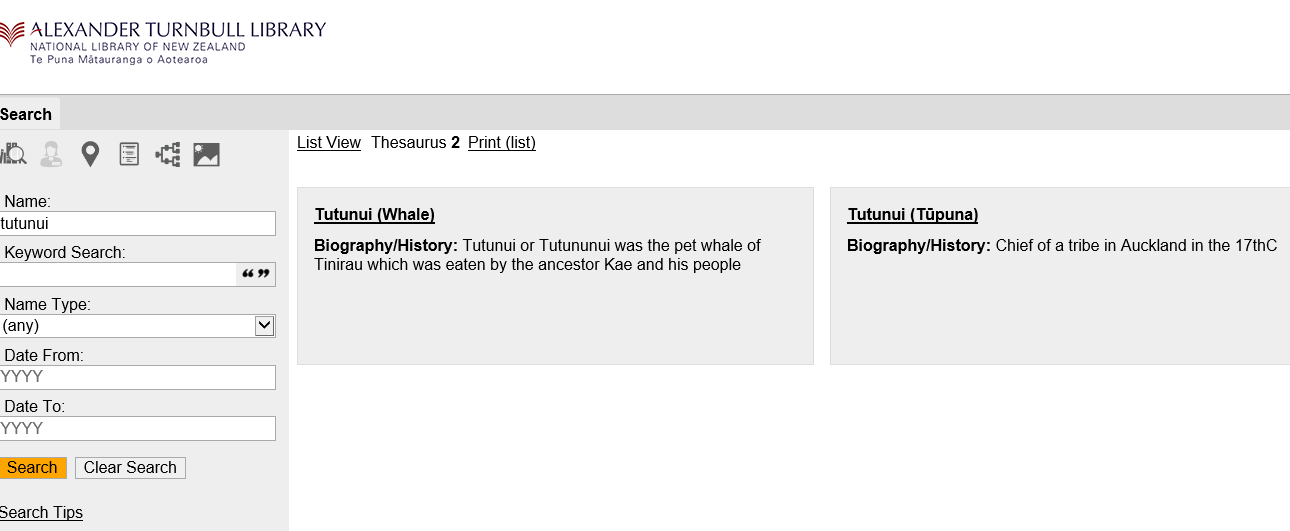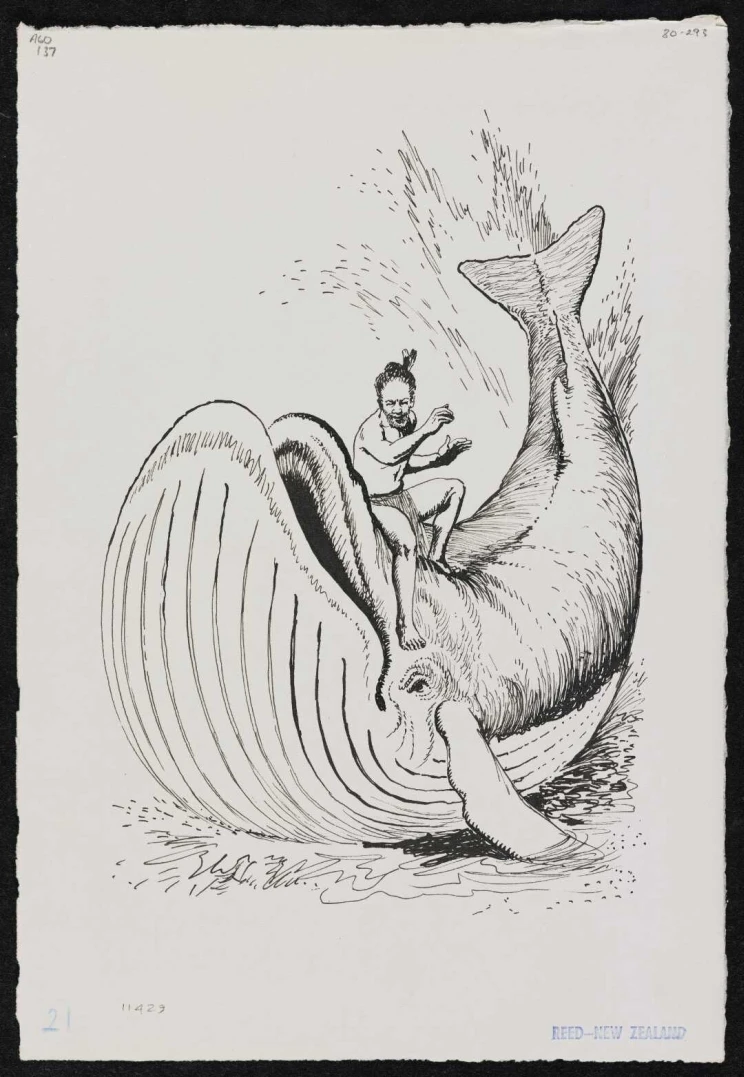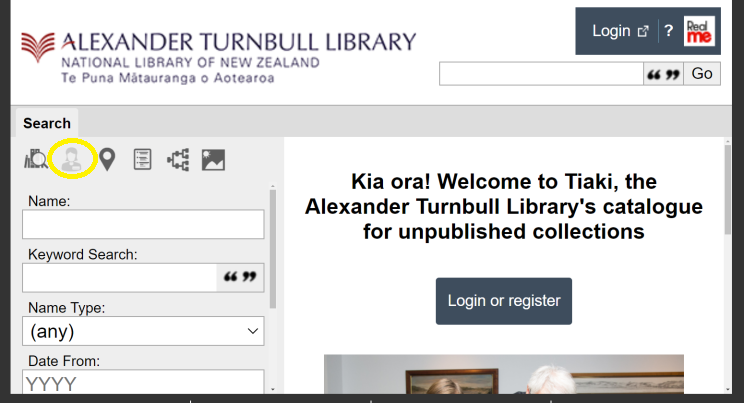What’s in a Tupuna name?
Katrina Tamaira and Ariana Tikao, from the Turnbull Library's Arrangement and Description team, highlight their recent work to update and improve more than 300 individual Māori name records in our database of unpublished collections.
Mātauranga Māori
In te ao Māori, the naming of people, places, and taonga is embedded in whakapapa, tikanga, and multi-layered stories. We have over 1,000 Māori names in our database. Researchers can look these names up and see what items we have connected to them. Māori names can be found throughout Alexander Turnbull Library collections — from photographs, maps and manuscripts to music, oral histories and digital ephemera.
Tiaki, meaning to ‘care for’, is the name of our database for unpublished, archival collections in the Alexander Turnbull Library. An important aspect of the work of the Arrangement and Description team is to care for the data about our collections, and to keep improving our records so whānau and other researchers can find taonga that relate to them.
Ko wai tō ingoa?
My colleague Katrina Tamaira and I have recently been researching nearly 400 indexed Names that were previously classified as ‘Tūpuna’. However, now that the Library follows international standards many ‘Tupuna’ didn’t have enough information to qualify as a Name under our current standard of practice.
We use an international encoding standard called Encoded Archival Context – Corporate Bodies, Persons and Families (EAC-CPF) for our ‘Name’ metadata.
In order to follow these standards a ‘Name’ index term can only be a Corporation (group), Person or Family, and so capable of creating records — for example, emails, letters, photographs, spreadsheets.
Using the international standard means that we can share our metadata easily with other institutions. It also helps people doing research to search our database and find items attributed to the correct people.
In order to meet the EAC-CPF standard, a ‘Name’ must include dates relating to when the person existed, and a source for where the biographical information came from.
Many ‘Tupuna’ names were tricky to find dates for, and lacked other biographical information. Some of our work involved determining whether ‘Tupuna’ names should be kept as Names or turned into other entities, such as Places or Subjects.
We decided that anyone who came here on a voyaging waka from Hawaiki would remain as a person Name. However, anyone before that time period, circa 1300, was not technically ‘Māori’, but were ancestors associated with older kōrero that took place in the Pacific. Many of those Tupuna Names, or those associated with undateable supernatural activities, became Subjects.
Through this work we have been finding some fascinating stories of voyages, battles, love stories, and courageous feats.
Ko Niwareka ia
One example is ‘Niwareka’, a tūrehu from Rarohenga, the Underworld. She married a mortal, Mataora who later mistreated her, causing Niwareka to flee back to her whānau in Rarohenga. Mataora followed her there, and received a moko by Niwareka’s father – this full facial moko is now known as mataora.
Mataora asked for Niwareka’s forgiveness, and promised to take care of her if she returned with him. She agreed and Mataora brought to earth the art form of tā moko, and Niwareka brought the art of tāniko.
Because this kōrero is ancient and not able to be given a date, a subject term was created for Niwareka. Subjects, including the new one for ‘Niwareka' (Māori mythology) can be found by clicking on the highlighted icon shown below.

Ko Tutunui rāua
One name that we had to untangle was ‘Tutunui’. There were two entities with that Name in our collections, one for a pet whale associated with an origin story set in Hawaiki times, and therefore more suitable as a subject term, and the other for a Ngāti Maniapoto ancestor.

A 'before' view of the catalogue showing previous 'Tutunui' terms for Whale and Tupuna.
The ancestor named Tutunui attempted an attack on a pā of the Waiohua people, at Maunga Kiekie (One Tree Hill) in Auckland. On the day of the attack, there was a lot of mist surrounding the pā, and Tutunui was instructing his warriors in a loud voice. When the mist cleared the Waiohua exclaimed "Ko te waha i nui, he iti te tangata!" meaning that the loud voice did not match Tutunui's short stature. This angered Tutunui. He charged ahead without his men, and was killed.
Several children were named after this incident to commemorate his death, Pēhi Tūkōrehu, Wahanui, and Te Whatakaraka. The first of these names recalls the covering of the mist, the second the loud voice, and the third the platform from which Tutunui’s body hung from the karaka tree. Those children went on to become important people within their iwi, and this story was remembered through the naming of those uri, or descendants.
Tutunui — the Ngāti Maniapoto ancestor

An updated view of the catalogue showing the new name record for 'Tutunui', the ancestor, complete with dates, biography and sources. (View record)
Tutunui — the mythical pet whale

An artwork relating to the whale, Tutunui, not the Ngāti Maniapoto ancestor of the same name. Dennis Turner, ca 1961. Ref: A-060-137. Alexander Turnbull Library.
Places and landmarks
Some other names were difficult to research because they did not name people, but rather places or landmarks. Online searching of various databases and websites for ‘Ngā Toka Ika’ brought up no dates, no biographical information, whānau names or possible iwi/hapū connections.
After gaining permission to access the restricted manuscript, my colleague identified the ‘name’ as a phrase relating to local fishing grounds. As well as being added to Tiaki as a subject term, Ngā Toka Ika will also be included in Ngā Upoko Tukutuku, a national database of te reo Māori subject terms.
Trusted sources
This work on these ancestral names, almost 400 of them, also involved adding sources for where our information came from. Some of our favourite sources we used during this work were ‘Ngā Iwi o Tainui’ by Bruce Biggs and Pei Te Hurinui Jones; Ross Calman and A W Reed’s ‘Reed Book of Māori Mythology’ and lots of other iwi histories and online resources.
We want your help
We realise though that iwi historians and descendants themselves hold a wealth of knowledge about their own tīpuna, so we would love to hear from you. Please let us know if you would like to correct any mistakes we have made, or if you have further details you would like to share with us so that we can further enhance these important name records.
You can do a keyword search in Tiaki to find your terms anywhere in the item's record, or else search under categories.
Tip: Try typing in different spellings of names as we often have more than one version of a name in our system. The various versions of someone’s name should be attached to a ‘preferred’ version of it.

The ‘person’ icon tab is where you can add a name to search, and the ‘side-on space invader’ looking icon is the one representing iwi-hapū names. These can be good places to start, to see if we have anything on your tīpuna or whānau.
To share any further information with us or suggest corrections please contact us via the Ask a librarian service.
Examples of records updated
Here are a few more examples of records that we updated:
Download the list of Māori names we updated
If you would like to see a more complete list of the names we worked on and their updated thesaurus terms download this spreadsheet.
Download the list of Māori names updated in our database (xlsx, 45KB)